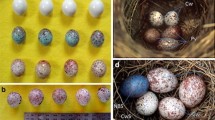Abstract
Hosts of brood parasites have evolved the ability to discriminate non-mimetic and even mimetic eggs, but not non-mimetic chicks. Here we demonstrate that the great spotted cuckoo Clamator glandarius does not provide its magpie Pica pica host with a super-normal stimulus that helps to avoid recognition, because single cuckoo chicks introduced into otherwise unparasitized magpie nests are not fed at a higher frequency than single magpie chicks introduced to parasitized magpie nests. Another series of experiments demonstrated that magpies have the ability to discriminate cuckoo chicks, mainly when these are introduced at the end of the nestling period, and especially when the cuckoo chick together with a magpie chick is presented to adult magpies outside the nest. This supports the idea that cuckoos exploit the obligatory reaction of magpies to feed all young that have been hatched in their nests and whose “signatures” they have learnt. Furthermore, the experimental cuckoo chicks in parasitized magpie nests were more likely to be accepted than they were in non-parasitized nests. This supports the hypothesis that magpies may learn to recognise their own nestlings as those present in the nest and may indicate that a comparison between cuckoo and magpie nestlings is the basis of discrimination.
Similar content being viewed by others
References
Alvarez F, Arias de Reyna L, Segura M (1976) Experimental brood parasitism of the magpie (Pica pica). Anim Behav 24:907–916
Beecher MD (1988) Kin recognition in birds. Behav Genet 18:465–482
Beecher MD, Beecher I, Hahn S (1981) Parent-offspring recognition in bank swallows. II. Development and acoustic basis. Anim Behav 29:95–101
Birkhead TR (1991) The magpies. Poyser, London
Briskie JV,. Sealy SG, Hobson KA (1992) Behavioral defenses against avian brood parasitism in sympatric and allopatric host populations. Evolution 46:334–340
Brooke M de L, Davies NB (1988) Egg mimicry by cuckoos Cuculus canorus in relation to discrimination by hosts. Nature 335:630–632
Cramp S (ed) (1985) The birds of the Western Palaearctic, Vol 4. Oxford University Press, Oxford
Davies NB, Brooke M de L (1988) Cuckoos versus reed warblers: adaptations and counteradaptions. Anim Behav 36:262–284
Davies NB, Brooke M de L (1989a) An experimental study of coevolution betwen the cuckoo, Cuculus canorus, and its hosts. I. Host egg discrimination. J Anim Ecol 58:207–224
Davies NB, Brooke M de L (1989b) An experimental study of coevolution between the cuckoo, Cuculus canorus, and its hosts. II. Host egg markings, chick discrimination and general discussion. J Anim Ecol 58:225–236
Dawkins R, Krebs JR (1979) Arms races between and within species. Proc R Soc Lond B 205:489–511
Harvey PH, Partridge L (1988) Of cuckoo clocks and cowbirds. Nature 335:586–587
Lack D (1968) Ecological adaptations for breeding in birds. Methuen, London
Lessells CM, Coulthard ND, Hodgson PJ, Krebs JR (1991) Chick recognition in European bee-eaters: acoustic playback experiments. Anim Behav 42:1031–1033
Lotem A (1993) Learning to recognize nestlings is maladaptative for cuckoo Cuculus canorus host. Nature 326:743–745
Mason P, Rothstein SI (1986) Coevolution and avian brood parasitism: cowbird eggs show evolutionary response to host discrimination. Evolution 40:1207–1214
Medvin MB, Beecher MD (1986) Parent-offspring recognition in the barn swallow. Anim Behav 34:1627–1639
Medvin M, Stoddard PK, Beecher MD (1993) Signals for parent-offspring recognition: a comparative analysis of the begging calls of cliff swallows and barn swallows. Anim Behav 45:841–850
Moksnes A, Roskaft E (1989) Adaptations of meadow pipits to parasitism by the common cuckoo. Behav Ecol Sociobiol 24:25–30
Mundy PJ (1973) Vocal mimicry of their hosts by nestlings of the great spotted cuckoo and striped crested cuckoo. Ibis 115:602–604
Nicolai J (1964) Der Brutparasitismus der viduinae als ethologisches Problem. Z Tierpsychol 21:129–204
Payne RB (1977) The ecology of brood parasitism in birds. Annu Rev Ecol Syst 8:1–28
Redondo T, Arias de Reyna L (1988) Vocal mimicry of hosts by great spotted cuckoo Clamator glandarius: further evidence. Ibis 130:540–544
Rothstein SI (1990) A model system for coevolution: avian brood parasitism. Annu Rev Ecol Syst 21:481–508
Soler M (1990) Relationships between the great spotted cuckoo Clamator glandarius and its magpie host in a recently colonized area. Ornis Scand 21:212–223
Soler M, Møller AP (1990) Duration of sympatry and coevolution between the great spotted cuckoo and its magpie host. Nature 343:748–750
Soler M, Soler JJ, Martinez JG (in press a) Duration of sympatry and coevolution between the great spotted cuckoo (Clamator glandarius) and its primary host, the magpie (Pica pica). In:
Rothstein SI, Robinson S (eds). Parasitic birds and their hosts. Oxford University Press
Soler M, Martinez JG, Soler JJ, Møller AP (in press b) Preferential allocation of food by magpies Pica pica to great spotted cuckoo Clamator glandarius chicks. Behav Ecol Sociobiol
Soler M, Soler JJ, Martinez JG, Møller AP (in press c) Magpie host manipulation by great spotted cuckoos: Evidence for an avian mafia? Evolution
Stoddard PK, Beecher MD (1983) Parental recognition of offspring in the cliff swallow. Auk 100:795–799
Zahavi A (1979) Parasitism and nest predation in parasitic cuckoos. Am Nat 113:147–159
Author information
Authors and Affiliations
Additional information
Communicated by M.A. Elgar
Rights and permissions
About this article
Cite this article
Soler, M., Martinez, J.G., Soler, J.J. et al. Chick recognition and acceptance: a weakness in magpies exploited by the parasitic great spotted cuckoo. Behav Ecol Sociobiol 37, 243–248 (1995). https://doi.org/10.1007/BF00177403
Received:
Accepted:
Issue Date:
DOI: https://doi.org/10.1007/BF00177403




